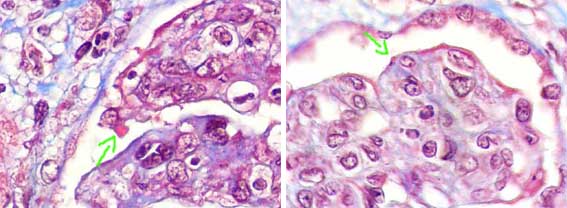Case
28 Diagnosis and discussion |
Versión
en Español |
|||
Go back to clinical information and images
Diagnosis:
Proliferative endocapillary acute glomerulonephritis, postinfectious.
Diffuse proliferaive endocapillary glomerulonephritis (GN) is defined as a cellular proliferation affecting mesangial areas and capillary lumens. Proliferating cells are mesangials, endothelials, and circulating inflammatory cells that have migrated to the capillary tuft. There is occlusion of capillary lumens due to cells and edema. The term "acute" indicates a clinical rapid evolution and, in many cases, is associated with abundant tuft neutrophils: "exudative".
The diagnosis of postinfectious GN is based on the demostration of a previous infection related to the glomerular disease. Morphologic features that suggest postinfectious GN are exudative lesions with a homogeneous diffuse pattern and presence of "humps" as seen in images 4 and 5 of the present case (see arrows in the next layaout).

In patient of this case there was a previous episode compatible with tonsillopharyngitis approximately 10 days prior to clinical presentation. It is also possible that the confirmed pneumonia is related to GN, but it is not possible to know exactly the infection "causing" this GN case.
In follow-up, three months after biopsy the patient is well, with normal renal function, normal serum complement levels, without hematuria or proteinuria and without symptoms. Resolution was complete. The patient did not receive steroids or other immunosuppressant.
Reason to present this case is the prominent "humps".
See the chapter Proliferative Endocapillary Glomerulonephritis of our Tutorial.
Go back to clinical information and images
Bibliography
-
Nasr SH, Markowitz GS, Stokes MB, Said SM, Valeri AM, D'Agati VD. Acute postinfectious glomerulonephritis in the modern era: experience with 86 adults and review of the literature. Medicine (Baltimore). 2008;87(1):21-32. [PubMed link]
- Sotsiou F. Postinfectious glomerulonephritis. Nephrol Dial Transplant. 2001;16 Suppl 6:68-70. [PubMed link] [Free full text]